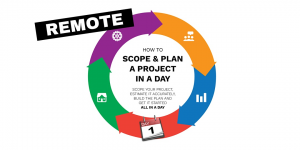SCOPING & PLANNING A PROJECT IN A DAY
€395
SCOPE & PLAN A PROJECT IN A DAY
In their book, ” Developing Products in Half the Time” the authors Smith and Reinertsen refer to the beginning of a project as “the fuzzy front end”. They say this: Time is an irreplaceable resource.When a month of potential development time is squandered, it can never be recovered – each month of delay has a quantifiable cost of delay.Our goal as developers is to find opportunities to buy cycle time for less than the cost of delay.These opportunities large and small appear throughout the development project process.
If the ” fuzzy front end” is where the opportunities to achieve large improvements in time to market – are greatest, then scoping and planning a project in a day is the best way of maxing out those opportunities.
Instead of the traditional approach to scoping and planning a project – through endless meetings – brainstorming sessions – workshops – review cycles – waiting time on sign off by key stakeholders. Alternatively we can concentrate all those activities into a one day focused workshop.The big idea here is that it’s possible to complete projects much more quickly than we do at the moment. By treating each project day as being precious and irreplaceable and you get far more productivity from that day – at the same time avoiding working long hours, burnout and death march projects.
BENEFITS
The benefits of this approach are:
- Projects are launched in a day. The project is actually up and running by the end of the day.There is no quicker and more cost-effective way to begin a project.
- Clear project objectives,project requirements and agreement / buy in from these stakeholders.
- Accurate estimates upon which firm commitments can be made.
- A clear picture of how the project will unfold.
- A kick-start to the project.
- Gain a competitive advantage.
THE METHOD
There are two key things that are key to making this method work for you. The first is to bear in mind that your objectve is to end the day with two deliverables – the scope document and planning document.The other is to spend the time as wisely as possible to achieve these two deliverables.
BOOK EARLY – LIMITED AVAILABILITY

Dublin 12 December 2025 [9.00 – 5.o0] 1 Day Workshop €595
Dublin 23 January 2026 [9.00 – 5.00] 1 Day Workshop £595
London 13 February 2026 [9.00 – 5.00] 1 Day Workshop £595
Dublin 23 February 2025 [9.00 – 5.00] 1 Day Workshop £595
London 6 March 2026 [9.00 – 5.00] 1 Day Workshop £595
Dublin 13 March 2026 [9.00 – 5.00] 1 Day Workshop £595
Description
BENEFITS FOR INDIVIDUALS & COMPANIES
‘Scope and Plan a Project in a Day’ methodology,is a very simple but effective process built around Light Project Management Practices.If you want to shorten a project there is one place where – more than any other
The greatest potential for shortening exists
This is right at the beginning, as soon as the idea for the project is born
How does it work?
Essentially, there is a 1-day session in which the plan is built;
Project stakeholders have to do some preparation before the 1-day session and there is some follow-up afterwards.
What are the deliverables from the Scope and Plan a Project in a Day Workshop?
- A clear definition of the project deliverables and key milestones
- The delivery date and schedule
- The effort and budget required
- Quality measures
- Project management responsibilities clearly defined
- A reporting structure
- A communication plan to keep the stakeholders up to date with project progress
- The principal assumptions on which the project is based
- Gantt Chart to graphically outline the project life cycle
- Risks identified and appropriate actions identified to minimize risks
- Any other findings and recommendation
Additional Information
| Date: | 17 June 2020, 8 July 2020, 12 August 2020 |
|---|




